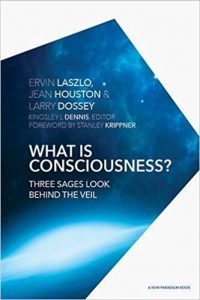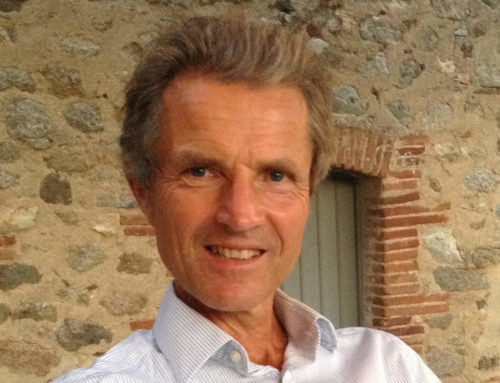Book review by David Lorimer
WHAT IS CONSCIOUSNESS?
Ervin Laszlo (SMN), Jean Houston, Larry Dossey (SMN), edited by Kingsley L. Dennis
SelectBooks, 2016, 156 pp.
ISBN: 978-1-59079-347-3
Last year, Ervin wrote to Jean and Larry asking them to send a summary of their interpretation of consciousness. The result was much longer than he expected, as printed in this book, which I read on my way back from Italy this week. It provides a succinct account of three important perspectives on consciousness, which share a common view of transcendent oneness. Both Larry and Jean refer to an interview with Max Planck, which is worth quoting here: ‘I regard consciousness as fundamental. I regard matter is derivative from consciousness. We cannot get behind consciousness. Everything that we talk about, everything that we regard as existing, postulates consciousness.’ He continues by stating that there is no matter of such and that it exists only by virtue of a force bringing the particle to vibration and holding it together in a minute solar system; ‘we must assume behind this force the existence of a conscious and intelligent mind. The mind is the matrix of all matter.’ The importance of this statement is hard to exaggerate, coming as it does from one of the pre-eminent quantum physicists of the last century after 50 years of research. As many readers will know, this sentiment can be echoed in the writings of many other physicists, as collected by Ken Wilber and more recently by Bob Jahn and Brenda Dunne. In this respect, the worldview of neuroscience lags behind, still fundamentally influenced by the mechanistic metaphor.
Jean’s contribution is entitled ‘Consciousness is the Quantum Field of the Cosmos’ and explains her more experiential take at the four levels of physical-sensory, psychological, mythical-symbolic and spiritual-unitive. Like Ervin, she considers the hologram an important theoretical concept, seeing the universe as having an outer body and an inner mind whereby the infrastructure of the mind mirrors the structures of the universe. In terms of consciousness, this is an interdependent co-arising, so that the level of reality we are able to access depends on our state of consciousness. She quotes Deepak Chopra as saying that ‘the future of God is the evolution of our own consciousness from separation to unity, from a fragmented mind to a whole mind, from thought which is in time to Awareness which is not in time.’ She gives a useful exercise where we can re-edit a significant incident in our lives that did not work out as we might have hoped, thus changing our feeling of the past. This also highlights the importance of imagination in its creative sense. Another key for her his archetypes as cosmic blueprints that we can tune into.
Larry directly addresses the inadequacies of the physicalist or materialist view of mind, pointing out that how we perceive ourselves as profound social and moral implications. The dominant physicalist view is not presented as a modest hypothesis, but rather as an incontrovertible fact, in spite of the lack of evidence and the frank admission on the part of many distinguished neuroscientists that they do not know how consciousness is produced in or by the brain. They rely on what Popper and Eccles called promissory materialism, the assumption that there will eventually be an adequate materialist account of consciousness. The irony is that other theories are criticised from this standpoint, which itself has no basis other than correlation and disqualifies the proponent – why should such theories be taken seriously if they are simply a deterministic outcome of brain processes?
William James pointed out more than a century ago that the hypothesis that the brain produces consciousness cannot adequately explain anomalies such as OBEs, NDEs and survival of consciousness and that we need some form of filter or transmission theory to account for these data. In a particularly felicitous phrase, Larry states that ‘empirical evidence shows that brains are separate, but minds are not’, as documented in his own book One Mind. The real problem is the incompatibility between scientific assumptions and the reality of conscious experience. Here Larry adds two useful quotations, one from Sir Arthur Eddington and the other from David Bohm: Eddington maintained that the idea of the universal mind is a fairly plausible inference from the present state of scientific theory, while Bohm asserted that deep down the consciousness of mankind is one. Overall, this is one of the best summaries of the current state of consciousness studies that I know.
Ervin Laszlo builds on the other two contributions while referring in more detail to some of the evidence for consciousness beyond the brain. A particularly arresting example concerns a chess match, where one of the players was discarnate – he only lost after 48 moves and the medium had no specialist knowledge of chess. Ervin quotes the intriguing ostensible account relayed by Rosemary Brown about the post-mortem state of Bertrand Russell, which I also quote in my own book Survival. It is an eloquent statement and one of the great ironies of 20th-century philosophy if true. Ervin moves on to explain his ideas about consciousness as a nonlocal projection of a cosmic hologram, which he relates to his theory of the Akashic Field. He ends with a personal credo about living the answer in terms of being a conscious human being as an intrinsic and infinite part of a universal mind. This means that the world is not outside us and we are not outside the world: the world is in us, and we are in the world. As Plotinus put it 1700 years ago, ‘we are within a reality that is also within us.’ In addition, we are part of an evolutionary drive towards coherence and wholeness; and since we are expressions of the same mind, we are in a deep sense part of each other, which has significant ethical implications for the emerging society of caring and sharing. The visionary content of this book can help catalyse the shift we all need to make.
Buy What is Consciousness? here.
